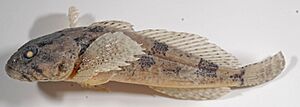Potomac sculpin facts for kids
Quick facts for kids Potomac sculpin |
|
|---|---|
 |
|
| Conservation status | |
| Scientific classification |
The Potomac sculpin (Cottus girardi) is a type of sculpin fish. It lives in freshwater rivers and streams. You can find this fish in parts of West Virginia, Maryland, Virginia, and Pennsylvania.
Contents
What the Potomac Sculpin Looks Like
The Potomac sculpin has a big head and a large mouth. Its eyes are on the top of its head. It has fins that look like fans on its sides, called pectoral fins. It also has two dorsal fins on its back that are connected.
This fish has small holes along its sides, called lateral-line pores, which help it sense things in the water. It usually has 26 or fewer of these pores. The sculpin also has four pelvic fins and fifteen pectoral fins. You might notice spots of color on its chin.
Most Potomac sculpins are about 7.8 centimeters (3.1 in) long. The longest one ever found was about 14 centimeters (5.5 in) long.
Where the Potomac Sculpin Lives
The Potomac sculpin makes its home in the James River area in Virginia. It also lives in the Potomac River system. This includes parts of Virginia, West Virginia, Maryland, and Pennsylvania.
These fish prefer small to medium-sized streams. They can handle water that is a bit warm. Where a sculpin lives in a stream can depend on whether it is a male or a female. Male sculpins often live in muddy areas or among water plants. Female sculpins usually live in parts of the stream where the water flows faster. Young sculpins, called juveniles, like streams where the water moves very slowly.
Potomac Sculpin Behavior and Diet
The Potomac sculpin is a meat-eater. It hunts and eats small water creatures. Its diet includes tiny crustaceans called copepods, young mayflies (nymphs), and small worm-like insects called chironomids. Sometimes, a Potomac sculpin might even eat other small fish.
Reproduction and Life Cycle
Potomac sculpins reproduce by spawning. This means the female releases her eggs into the water, and the male fertilizes them. Scientists believe they usually spawn in early spring or late winter.
How We Protect the Potomac Sculpin
The International Union for Conservation of Nature (IUCN) says the Potomac sculpin is a species of "least concern". This is good news! It means the fish is not in danger of disappearing.
There are a few reasons for this. The Potomac sculpin lives in a large area and has many different groups of fish. Its population is also quite stable. Plus, there are no big threats right now that could harm many of these sculpins.


